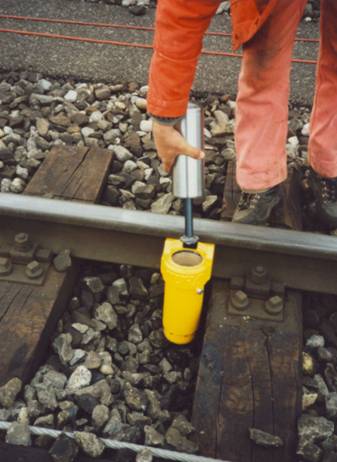Rail Retarders/Arresters
Sigra supplies and services Ultradynamics Rail Retarders and Arresters. Over 300,000 of these units are in service throughout the world assisting in the control of rollingstock movements.
Rail Fog Retarder
Heavy duty, single acting, serviceable damper designed to slow the return of the wing rail on spring frog switches. Spring frog switches are usually remotely located. The spring loaded wing rail is biased to the main track, so as the wheels of trains approaching on the side track hit the wing rail, it springs open to allow the train through. The damper slows the return of the rail for about 30 seconds thus reducing the number of wheel/rail impacts and so reducing wheel/rail wear.
Retarders/Arresters
There are 2 types, Trackmaster and High Capacity. Trackmaster is larger. Each has its own advantages and Ultra can advise which is the most suitable for the application. Arresters are retarders set at zero control speed. Control speeds can be set 0 - 4.25m/s. Most are set at 1-1.5m/s because this is the safe buffing speed of wagons when coupling.
Retarders are limited to 15km/h normally or up to 25km/h exceptionally. In order to allow whole trains to be pulled over retarders at unlimited speeds there is a pneumatically retractable version of the High Capacity.
Basically, piston retarders can be used anywhere where speed control on a gradient is required.
Retarders In Hump/Gravity Fields
These marshaling yards are partly or wholly built on grades. Wagons are separated at the hump then rolled under gravity through the switching area into the appropriate siding. The sidings may or may not be on a grade but the switching area always is.
Due to the difference in wagon rolling resistance and weight you need retarders to control their speed. Many yards use clasp retarders in the switching area. These are large air or hydraulically powered beams which squeeze the wheels at rail level. They can be manually or automatically controlled. They are mostly in the switching area. Typically just 3 or 4 in a yard. Once a wagon has left the clasp you have no more control, so if the clasp operation is not perfect wagons can stall too early or over speed.
Ultra retarders can be used in place of clasp retarders or in addition to them. Ultra retarders are much quieter and require no human input at all. If wagons speed up or slow down, due to wind for example, then each Ultra retarder will retard or idle as appropriate (Continuous Control).
Servicing of Ultra retarders is simple. Individual retarders can be removed and replaced with a spare and then sent to Sigra in Sydney for service. This does not affect yard throughput and can be done in between yard operations. Each clasp retarder requires possibly 25% of the yard to be closed or more, often for days, while engineers from different disciplines carry out repair or maintenance. They can also leak oil in sufficient quantity to threaten water collection areas.
Marshaling yards with correct gradients and Ultra retarders have a very high safety record as there are no people necessary in the yard. For this reason they are highly suitable for use with dangerous cargo’s (petrol/chemical, nuclear etc), where wagon speed control is important.
Safety Tracks
Any side track where there is a grade, with a risk of wagons rolling out of control, can be controlled by Ultra retarders. Sometimes used in or approaching workshops, train washing facilities etc. Retarders have been supplied to an axle manufacturer to stop individual axles from rolling out of control. Retarders can be used to limit speeds approaching buffers.
Arresters
Arresters can be used on zero gradient where an unpowered train or wagons needs to be stopped. Arresters will stop a train on a grade but not hold it permanently - the internal valves will leak over time. They are not intended to replace buffers. A typical use is to stop wagons rolling out indiscriminately into flat sidings. Without arresters each wagon will roll and stop at different points dependent on its rolling resistance.
A few arresters are often used in mineral tipplers or industrial wagon loading areas to stop wagons rolling away from a loading position, e.g. iron ore, cement works, printing works (paper roll loading) etc.




